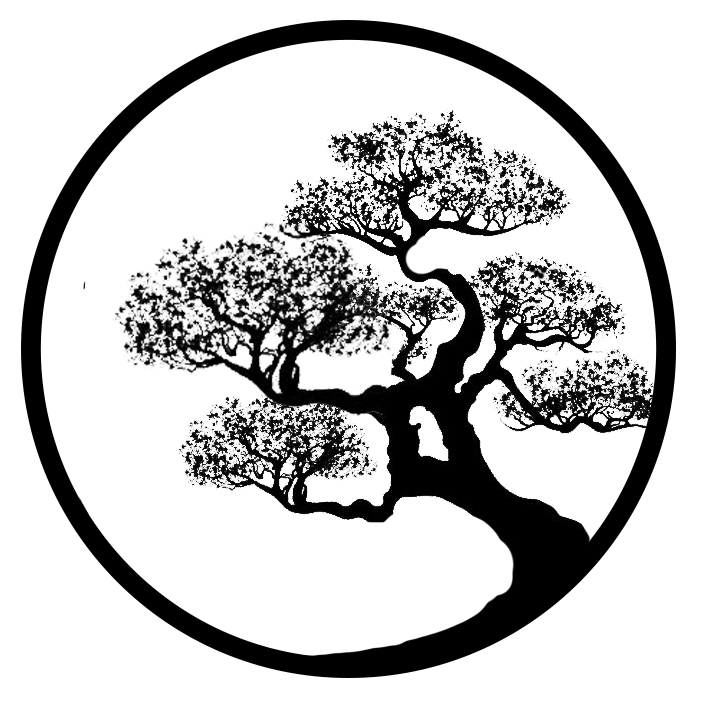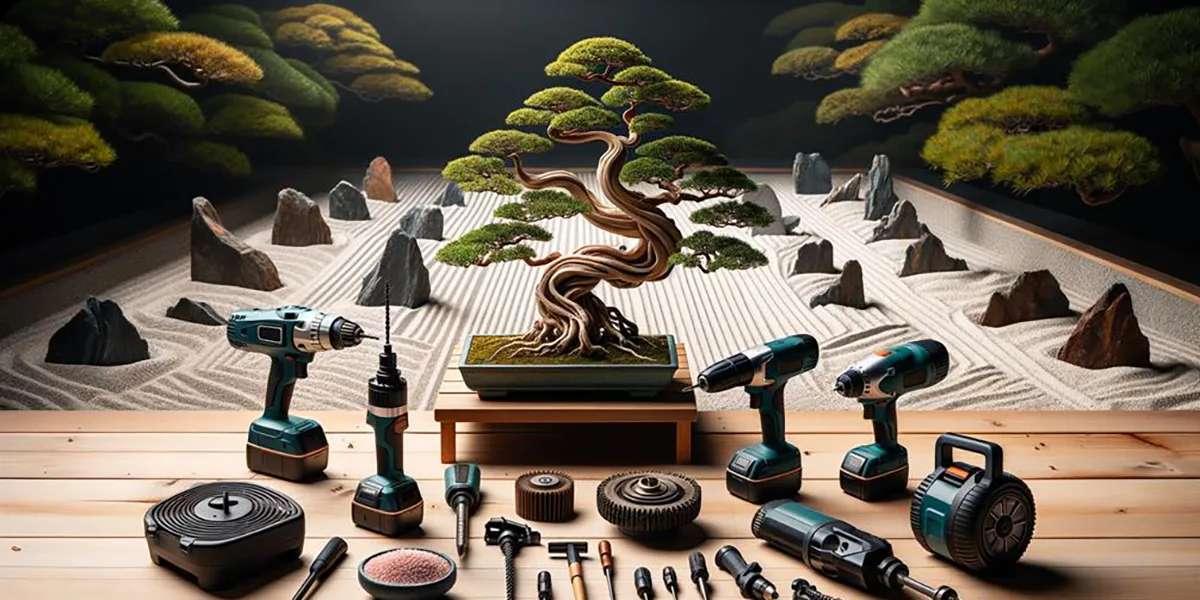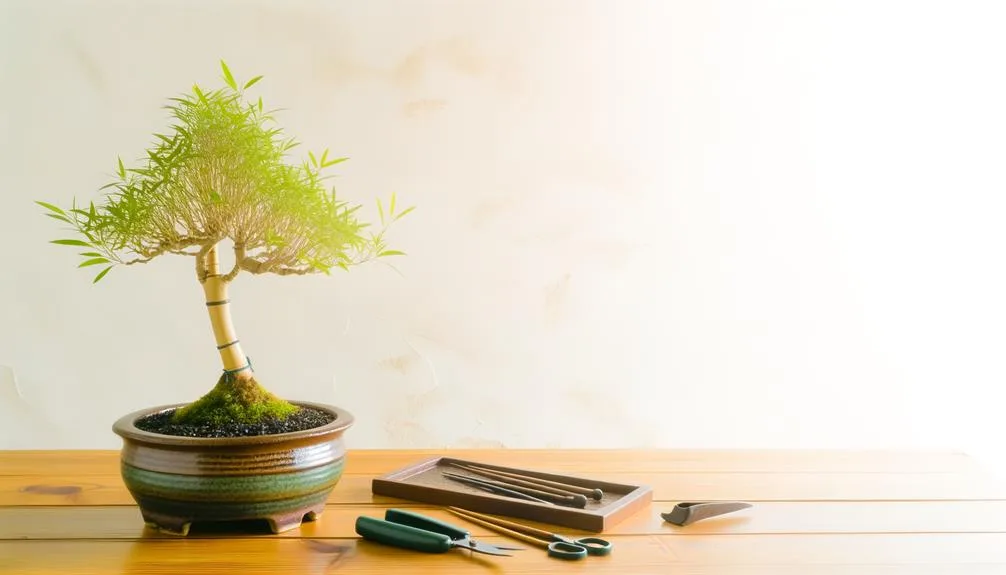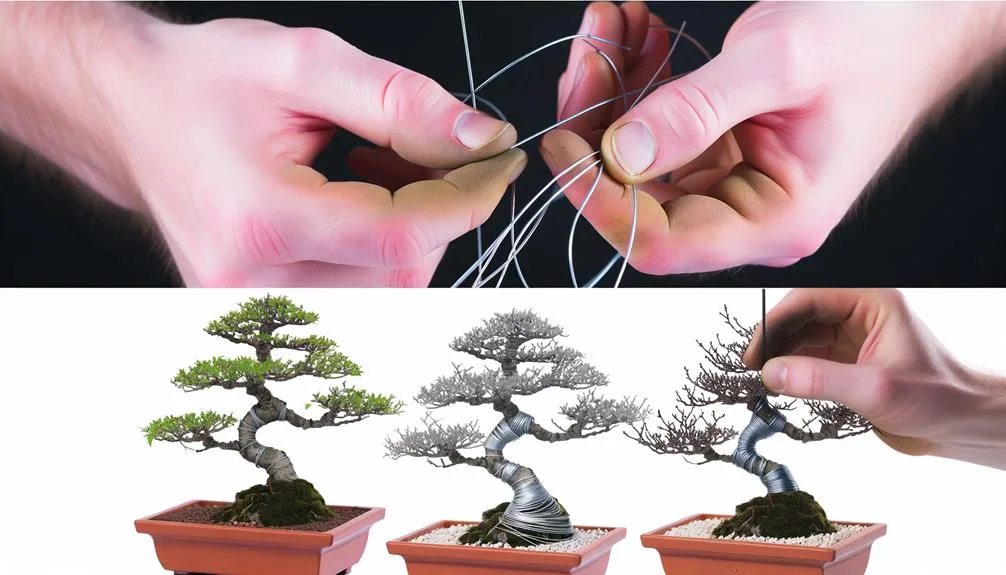Bonsai, an ancient art form, requires not just patience and skill but also the right set of tools. Each tool, from the delicate Bonsai scissors to the robust Knob Cutters, plays a crucial role in shaping these miniature masterpieces. This guide delves into the essential tools every bonsai enthusiast needs, offering insights into their use, maintenance, and the craftsmanship behind them.
Bonsai tools are more than just instruments; they are extensions of the artist’s hands. The Japanese bonsai tools are renowned for their quality and precision. Crafted with care and tradition, these tools are not merely manufactured; they are born from a legacy of artisan craftsmanship. The Hand-forged steel used in these tools ensures durability and precision, making them a worthy investment for both beginners and seasoned enthusiasts.
Selecting the right tool is vital. Whether it’s the Bonsai pruning shears for trimming leaves or the Bonsai wire cutters for shaping branches, each tool has a specific purpose. For those starting their bonsai journey, understanding the function and proper use of each tool is key. Bonsai tool kits often provide a good range of basic tools, while more advanced sets are available for those looking to expand their collection.
Maintenance is equally important. Regular Bonsai tool care and sharpening ensure that your tools are always ready for the next cut. Proper storage solutions not only organize your tools but also protect their integrity, ensuring they last for years.
As we explore the world of bonsai tools, remember that these instruments are your partners in the creative process. They shape, trim, and transform, helping you bring your vision to life. With the right tools in hand, the art of bonsai is not just a hobby; it’s a journey of continuous learning and growth.
Key Takeaways
- Bonsai tools are specialized instruments essential for the precise shaping and care of bonsai trees, with each tool serving a specific purpose.
- Quality matters in bonsai tools. Hand-forged steel tools from Japan are renowned for their durability and precision, representing a blend of tradition and craftsmanship.
- Beginners should start with a basic toolkit, including pruning scissors, wire cutters, and a knob cutter, and gradually expand their collection as their skills develop.
- Regular maintenance of bonsai tools, including cleaning, oiling, and sharpening, is crucial for their longevity and effectiveness.
- Understanding the correct use of each tool and practicing proper techniques are key to successful bonsai shaping and maintenance.
- The global bonsai community is a valuable resource for learning, sharing, and discovering innovative tools and techniques.
- Investing in the right tools and caring for them is not just an investment in your hobby but in a lifelong journey of growth and discovery in the art of bonsai.
Understanding Bonsai Tools
With bonsai, each tool has a unique role, designed to perform specific tasks that contribute to the overall health and aesthetic of the miniature tree. The Essential Toolkit comprises the backbone of bonsai maintenance, with each instrument tailored for precision and effectiveness.
Pruning Scissors are perhaps the most frequently used tool. Their sharp blades are ideal for trimming leaves and small branches, allowing for clean cuts that promote healthy growth. The precision of these scissors is paramount, as they shape the very essence of the bonsai’s appearance. For intricate work, especially on smaller trees, Bonsai scissors are indispensable.
Knob Cutters, on the other hand, are designed for more substantial tasks. They are used to remove knobs and unwanted branches, creating a smooth surface that heals quickly. The concave design allows for cuts that leave minimal scarring, encouraging a natural-looking growth over time. These cutters are essential for maintaining the tree’s structure and ensuring its longevity.
Wire Cutters are another critical tool, especially when it comes to shaping. Bonsai artistry often involves wiring branches to guide their growth and create the desired form. The Bonsai wire cutters are specifically designed to cut through wire without damaging the tree. They provide a clean cut, ensuring the wire can be removed safely when the time comes.
Understanding these tools, their purposes, and how to use them effectively is the first step in mastering the art of bonsai. With the right knowledge and care, these tools become extensions of your own hands, guiding each miniature tree towards its fullest potential.
The Craftsmanship Behind Bonsai Tools
The artistry of bonsai is not confined to the trees alone; it extends to the very tools used to shape them. The Japanese Craftsmanship and Tradition behind bonsai tools is a testament to the dedication and skill involved in their creation. These tools are not just made; they are crafted with a legacy of precision and care.
The history of bonsai tools is deeply intertwined with the history of bonsai itself. For centuries, artisans in Japan have been perfecting the art of tool-making, passing down techniques from one generation to the next. This tradition of Artisan Craftsmanship ensures that each tool is not only functional but also a work of art. The attention to detail is evident in every curve and edge, designed to provide the utmost precision and ease of use.
At the heart of quality bonsai tools is Hand-forged Steel. This material is chosen for its durability and ability to hold a sharp edge. Hand-forging is a meticulous process, involving heating, hammering, and shaping the steel by hand. This method creates tools that are robust yet flexible, capable of making the precise cuts necessary for bonsai artistry.
The finish and feel of hand-forged tools are distinctive. They have a heft and balance that feel right in the hand, making them a pleasure to use. The rough finish, often seen on higher-quality tools, provides a better grip and control, allowing for more accurate cuts.
Understanding the craftsmanship behind bonsai tools can deepen your appreciation for the art of bonsai. These tools are more than just instruments; they are a link to a tradition of craftsmanship that has been honed over centuries. With proper care and respect, they will serve you well, helping you shape your bonsai trees into living works of art.
Selecting the Right Bonsai Tools
Choosing the appropriate tools is a critical decision that can significantly impact the health and aesthetics of your bonsai. The selection process involves understanding the difference between tools for beginners and professionals and considering various factors like material, durability, and price.
Tools for Beginners vs. Professionals: If you’re just starting, a basic Bonsai tool kit can provide the essentials without overwhelming you. These typically include pruning scissors, a small pair of wire cutters, and maybe a knob cutter. As your skills and bonsai collection grow, you’ll recognize the need for more specialized tools. Professionals and serious enthusiasts often invest in higher-quality, durable tools that offer greater precision and longevity. These might include various sizes of scissors and cutters, root hooks, and rakes, each serving a specific purpose in the bonsai’s care and styling.
Factors to Consider When Buying Bonsai Tools: Material is a primary consideration. High-carbon steel is a popular choice for its sharpness and durability, but it requires regular maintenance to prevent rust. Stainless steel options offer rust resistance and are generally easier to maintain. The craftsmanship, as discussed earlier, also plays a significant role in the tool’s quality and price. Hand-forged tools from Japan are highly sought after for their superior performance and durability but come at a higher cost.
When considering the price, think of bonsai tools as an investment. Cheaper tools might save money upfront but can cost more in the long run if they need frequent replacement or damage your plants. Quality tools, well-maintained, can last a lifetime and provide a better bonsai shaping experience.
Lastly, look for recommendations and reviews from the bonsai community. They can provide insights into the best tools for various tasks and which brands offer the best value for money.
Selecting the right bonsai tools is about balancing cost with quality, functionality, and your specific needs. With the right tools in hand, you’re well-equipped to care for and create beautiful bonsai.
Maintenance and Care of Bonsai Tools
Proper maintenance and care are crucial for extending the life of your bonsai tools and ensuring they perform at their best. Regular upkeep not only preserves the tools’ functionality but also prevents the spread of disease between plants. Here’s how you can keep your tools in top shape.
Keeping Your Tools in Top Shape: After each use, clean your tools to remove sap, dirt, and debris. For tools like pruning scissors and knob cutters, wiping them with a cloth and applying a bit of oil can prevent rust and keep the mechanisms smooth. For tools that have come into contact with diseased plants, sterilize them with alcohol or a bleach solution to prevent cross-contamination.
Sharpening techniques are essential for maintaining the effectiveness of cutting tools. Dull blades can damage your bonsai by crushing instead of cutting cleanly. Learn how to sharpen your tools correctly or take them to a professional. A well-sharpened tool makes a clean cut that heals faster and looks better.
Storage Solutions for Longevity: Proper storage is just as important as cleaning and sharpening. Keep your tools in a dry, clean place to prevent rust and damage. Many enthusiasts use tool rolls or special cases to organize their tools and protect them from moisture and dust. Ensure that each tool has its spot, and they’re not knocking against each other, which can cause dulling or damage.
Regular maintenance not only extends the life of your tools but also makes your bonsai care routine more enjoyable and effective. Well-cared-for tools are a pleasure to use and contribute to the health and beauty of your bonsai.
Techniques and Tips for Using Bonsai Tools
Mastering the use of bonsai tools is as much an art as it is a skill. Each cut, twist, or trim you make with your tools can significantly impact the shape, health, and growth of your bonsai. Here are some techniques and tips to help you use your tools effectively and safely.
Pruning and Shaping with Precision: Pruning is one of the most common tasks in bonsai care, and doing it correctly is vital. Always use sharp Bonsai scissors or shears for pruning. Make clean cuts at an angle that promotes healing and minimizes scarring. Understand the growth pattern of your bonsai to prune strategically, encouraging the tree to develop the desired shape and size.
When shaping with wire, use the appropriate gauge to match the branch’s thickness. Bonsai wire cutters are designed to cut the wire without damaging the tree. Apply the wire evenly and not too tightly, as this can cut into the bark as the branch grows. Regularly check wired branches and remove the wire before it causes any damage.
Advanced Bonsai Techniques: As you gain more experience, you might want to try more advanced techniques like creating jin (deadwood on branches) and shari (deadwood on the trunk). These techniques require careful use of tools like jin pliers and carving tools. Always work slowly and step back frequently to assess your progress. Remember, it’s easier to take more off later than to fix a cut that’s too deep.
Using bonsai tools effectively requires practice, patience, and a steady hand. Always work with a clear vision of what you want to achieve, and don’t rush the process. Over time, you’ll develop a feel for how each tool works and how to use them to bring out the best in your bonsai.
The Future of Bonsai Tools
As the art of bonsai continues to evolve, so too do the tools used to cultivate these miniature landscapes. Innovations in tool design and a growing global community of enthusiasts are shaping the future of bonsai tools, making them more effective, accessible, and sustainable.
Innovations in Tool Design: New materials and technologies are being incorporated into bonsai tools, enhancing their functionality and user experience. Ergonomic designs are becoming more prevalent, reducing strain and fatigue during prolonged use. Lightweight yet durable materials like advanced alloys and composites are being explored to extend the tools’ lifespan and performance. Additionally, there’s a growing interest in sustainable and eco-friendly options, such as tools made from recycled materials or designed to be easily recyclable at the end of their life.
The Global Bonsai Community and Tools: The bonsai community is a vibrant and diverse network of enthusiasts, artists, and professionals. As it expands globally, there’s a greater exchange of ideas, techniques, and tools. This cross-pollination is leading to innovative tool designs and adaptations to suit different styles and species of bonsai cultivated around the world. Online platforms and forums allow for the sharing of reviews, recommendations, and modifications, further driving the evolution of bonsai tools.
The future of bonsai tools is one of continuous improvement and innovation. As we look forward, we can expect tools that are not only more effective and easier to use but also more in tune with the needs of both the trees and the planet.
What are the essential bonsai tools for beginners?
Beginners should start with a basic toolkit that includes pruning scissors, a small pair of wire cutters, and a knob cutter. These tools will cover most basic pruning and shaping tasks.
How do I maintain and care for my bonsai tools?
After each use, clean your tools to remove sap and debris. Apply oil to prevent rust and keep the mechanisms smooth. Sharpen cutting tools regularly and store them in a dry, organized place.
What is the difference between standard and professional-grade bonsai tools?
Professional-grade tools are typically made from higher-quality materials and offer greater precision and durability. They often come with a higher price tag but are a worthwhile investment for serious enthusiasts.
How do I choose the right tool for a specific bonsai task?
Consider the task at hand. Use pruning scissors for trimming leaves and small branches, knob cutters for removing larger branches, and wire cutters for shaping. Research and understand the specific purpose of each tool.
Can I use regular garden tools for bonsai maintenance?
While it’s possible, regular garden tools are not designed for the delicate work required in bonsai and can damage the plants. Bonsai tools are specifically designed for precision and care, making them a better choice.
Bonsai Tools Articles
Bonsai Wiring: Best Wires and Techniques
Bonsai wiring is an essential technique for shaping and guiding the growth of miniature trees, akin to how a sculptor uses clay. The article emphasizes that not all wires are created equal, and the choice between aluminum or copper, thick or thin, significantly impacts the bonsai’s outcome. It’s a continuous process requiring regular checks and careful wire removal to prevent damage.
The right wire, about a third the thickness of the branch, is crucial, and for beginners, aluminum is easier to work with, while copper suits hardy bonsai. The article also delves into techniques for wiring bonsai, stressing the importance of the right wire type, careful application, and regular monitoring to shape the tree effectively without causing harm.
For a more in-depth understanding of the best wires and techniques for bonsai wiring, read more.



